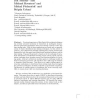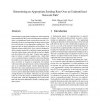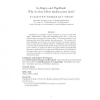6409 search results - page 1267 / 1282 » A Computational Algorithm for Origami Design |
BMCBI
2007
13 years 7 months ago
2007
Background: Elucidating biological networks between proteins appears nowadays as one of the most important challenges in systems biology. Computational approaches to this problem ...
IJIIDS
2008
13 years 7 months ago
2008
: Growing importance of distributed data mining techniques has recently attracted attention of researchers in multiagent domain. Several agent-based application have been already c...
CN
2007
13 years 7 months ago
2007
Determining an appropriate sending rate when beginning data transmission into a network with unknown characteristics is a fundamental issue in best-effort networks. Traditionally,...
JCM
2008
13 years 7 months ago
2008
In this paper, we present a new simulation platform for complex, radio standard spanning mobile Ad Hoc networks. SimANet - Simulation Platform for Ambient Networks - allows the coe...
IM
2007
13 years 7 months ago
2007
PageRank is a popularity measure designed by Google to rank Web pages. Experiments confirm that PageRank values obey a power law with the same exponent as In-Degree values. This ...



